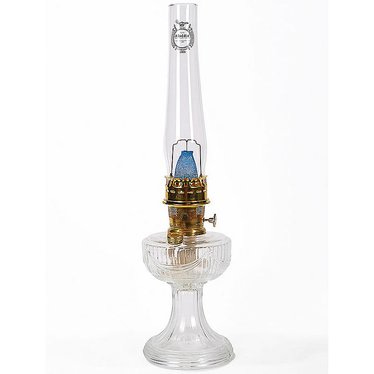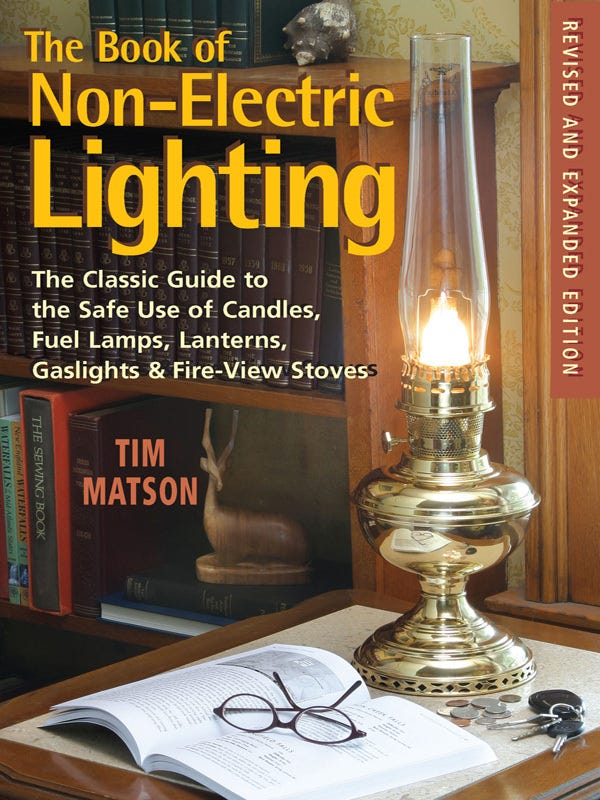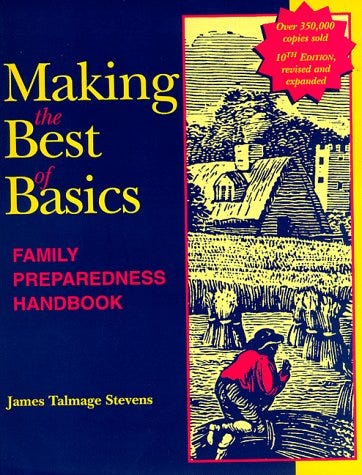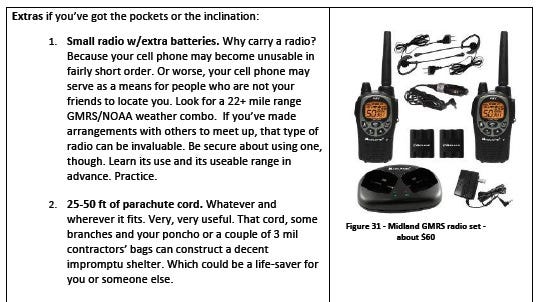Preparedness
Tools for Possibilities: issue no. 42
Once a week we’ll send out a page from Cool Tools: A Catalog of Possibilities. The tools might be outdated or obsolete, but the possibilities they inspire are new. Sign up here to get Tools for Possibilities a week early in your inbox.

Bright, oil/kerosene-powered lighting
Aladdin lamps have been around for 100 years. At their brightest, they’re about as radiant as a 60W incandescent light bulb, so you can easily read by them. They burn kerosene or lamp oil, and employ a cylindrical wick that heats a Welsbach mantle (it’s bright incandescence comes from thorium and cerium oxides). Similar to a lantern, but without the pumping and compressed air hissing. As such, the Aladdins are perfectly silent. They’re also more fuel-efficient than a pressure lantern, yet provide almost the same amount of light. Though they’re not more fuel-efficient than an average oil lamp, they can make a typical oil lamp look like a nightlight.
The lamp on the right (above) does not use a mantle, just a wick. They are both using the same fuel; I use Klean-Strip’s “Klean-Heat” which is a purified kerosene substitute usable anywhere kerosene is specified. A bowl of fuel can put out a lot more lumen-hours than a battery-operated lamp, making the Aladdins perfect for off-grid use or in the event of a power failure. I have an off-grid cabin in San Benito County south of the Pinnacles National Monument. Though I spend most of my time at my on-the-grid home, I’m partial to using an Aladdin at both residences. After trying other lamps, including a basic oil lamp I bought at Wal-Mart, I finally got Aladdin’s Genie III shelf lamp, the basic no frills version.
When properly adjusted they are essentially odourless and smokeless (the only time there is a slight smell is right after extinguishing the flame). By raising and lowering the wick, you can dim the lamp, too. If you raise the wick too high, though the fuel/air mixture becomes too rich and they start to soot/smoke, just like any other oil lamp. Properly adjusted, the wicked fuel creates a blue flame that heats the mantle. An optional chimney extender creates more updraft allowing you to operate the wick higher and get even more light. They recommend this for high-altitude (5000-ft.) operation. — Bruce Bowen

Simple lamps
The Book of Non-Electric Lighting
For off-the-grid living, you have a lot of options for non-electric lighting. (Solar-battery powered LEDs are not covered here.) This booklet goes through the advantages and disadvantages of different types of petrol-burning lamps. — KK
- Fuel Kerosene is the standard fuel for wick lamps. The term kerosene is used loosely to describe a thin flammable oil with a rather high ignition or flash point, roughly 160°F. That high ignition temperature makes kerosene safer for household use than more volatile alcohol or gasoline–in fact, a lighted match can be dunked in a pot of kerosene without igniting it.Kerosene and paraffin fuel lamps are distinguished by their wicks and fuel reservoirs. Pictured here left to right are a single wick with transparent glass reservoir, a duplex wick with ceramic reservoir, and a round wick with brass reservoir.
- The Chimney The Aladdin chimney is easy to recognize. At 12.5 inches, it is taller than most lamp chimneys. With only a slight outward curve to accommodate the mantle, it looks more like a glass smokestack than a traditional bell-shaped tapering lamp chimney. This sleek design represents a pinnacle in firelight aerodynamics: the high-velocity draft chimney makes it possible for the Aladdin to burn 94 percent oxygen and 6 percent kerosene, producing 125 candlepower. No other unpressurized liquid fuel lamp delivers such brilliant light.

Classic prepper guide
The latest end-of-the-world scenario is past. As usual I did nothing. But now that the apocalyptic hysteria is over, and no one expects Armageddon, I’m convinced this is the time to treat preparedness seriously. This dense workbook has long been considered the bible of the food storage and family preparedness crowd. Preparedness as in: be ready for any long-term disaster or crisis. A newly revised and expanded 12th edition has everything from how to store the basics (and how much), to how to cook ‘em, and how to keep water and stay healthy. Up-to-date and exhaustive. Yeah, it’s from Utah, so it dispenses wellworn, almost comfortable, anxiety. — KK
- Water that is bacteria-free when stored in thoroughly clean containers will remain safe for several years. Tests of water quality after long-term storage showed that water stored properly for several years could not be distinguished by appearance, taste, or odor from water recently drawn from the same source. However the principle of rotation is the best guarantee for monitoring stored water’s purity and taste.
- Treating Contaminated Water
Basic Bleach Method
For emergency treating of water of unknown quality, use any household bleach containing sodium hypochlorite (5.25% solution) without soap additives or phosphates. By using common household bleach as a chemical treatment method, large amounts of safe drinking water can be provided quite inexpensively. - Inventory management for basic in-home food storage is very simple–and hopefully, by now, very familiar:
1) Store what you eat.
2) Eat what you store.
3) Use it or lose it! - Fumigating Wheat for Storage
Carbon dioxide released from evaporating dry ice will kill all animal life in the container. The freezer will kill all live bugs–but not necessarily the eggs–over an extended period of time. It’s always best to refreeze the previously frozen wheat after 30 days to assure that any eggs hatched since the last treatment are killed.

Free archive of survivalist info
Tomorrow, the end of the world won’t happen. Even world economic collapse, or the total failure of the US government won’t happen without preliminary disruptions. Prepping now for that vague doomsday scenario is plain nuts. But regional natural disasters are almost a certainty. Prepping for survival of a large-scale hurricane, tornado, earthquake with a few days backup at home is a good idea. How do you prep? Most die-hard survivalists take the the “stockpile and defend” strategy, constructing doomsteads, which may or may not work in a natural disaster. Usually going with a “mobile and agile” strategy, with a ready “bug-out bag,” is better — but this is mostly a matter of temperament because we don’t have a lot of data of what actually worked in actual past disasters. (If you know of real data examining the value of home preparation please leave a link. Most of the evidence used in the survivalist prep world is Hollywood movies.)
But at the very least you should know what your survivalist options are. There are a zillion “prepper” books each one with more elaborate schemes and crazier than the one before it. Underground bunkers are only the tip. Selling doomsday (vs wilderness) survivalist advice is big cottage industry. I refuse to pay for this nonsense. The Survival Library is an open online archive of self-sufficiency, self-reliance instructions, PDFs, and videos that appear on other sites for free. It is easy to weed through. Some of the information, like welding instruction, or raising rabbits, or how to start a fire with no matches is useful whether or not you believe that the UN is sending black helicopters to take away your machine gun in the basement. The free downloadable PDF of the 500-page LDS (Mormon) Prep Manual is particularly interesting and for most normal people, all the prep literature you’ll ever need. — KK
Disaster Lessons
Right after a major disaster, nobody’s in charge. You self-start or nothing happens.
Assume that people can be trapped in any collapsed building. When searching a building call out “Anybody in there? Any body need help? Shout or bang on something if you can hear me.” Give trapped people all the information you’ve got. Enlist their help. Treat them not as helpless victims but as an exceptionally motivated part of the rescue team.
Join a team or start a team. Divide up the tasks.
Encourage leadership to emerge. Most action in a disaster is imitation. Most effective leadership is by example.
Bystanders make the convenient assumption that everything is being taken care of by the people already helping. That’s seldom accurate. If you want help, ask. If you want to be helped, ask!
Volunteers are always uncertain whether they’re doing the right thing. They need encouragement — from professionals from other volunteers, from passersby.
— Stewart Brand, Essential Whole Earth Catalog
Tips
- To track whether the dishes in your washer are clean, use a wet erase marker to write “Dirty” or make a fancy “D” on the inside door of your dishwasher when loading dirty dishes. When you run the dishwasher the mark washes away, so you’ll know they are clean. — Carl DeCesare
- When I need to make a hot compress I put dried beans (preferably lentils) in a pillowcase and heat in the microwave for a minute or two. It’s cheap, easy, doesn’t smell horrible, and retains heat for quite some time. Reusable, too. — Courtney Ostaff
- Wooden, spring loaded clothes pins are one of the handiest gadgets in the kitchen. They are very cheap and long lasting. I have a couple dozen in use at any one time fastening the open tops of almost any kind of food that comes in a bag. This can be a bag of chips, bread in a bag, the cereal package inside the box, bags of half used frozen foods. Clothes pins are way better than twist ties, rubber bands, and the standard bread bag clip. They can also be used to hang up damp dish clothes, towels, and pot scrubbers. I have a wire rack over my sink that holds many sink related tools, as well as items hung by clothes pins to dry. — Michael Kuhn
- I cook a lot and like to use garlic. One downside of properly cleaning and chopping and slicing garlic is the smell permeates your skin. Years ago, I heard on NPR that if you rubbed your hands under cold water with something made of stainless steel, the smell would be eliminated. I didn’t believe it, but it works. You can buy “fancy” soap-shaped or garlic-shaped stainless steel objects to do thiswith, but no need. Go into your drawer and get out a butter knife or spoon instead. This really works! — Michael Raab






